Travel and Culture: Bermuda, just a short flight to paradise
By Cornelia Seckel
ART TIMES Winter 2013
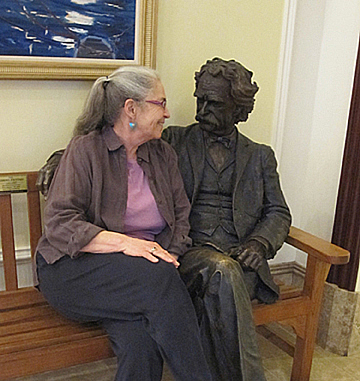 Cornelia Seckel enjoying a chat with Mark Twain, a frequent visitor to Bermuda |
The timing could not have been more perfect when I got an email from Lauren Pike at Lou Hammond & Associates asking if I would like to explore Bermuda with a group of other writers. We spent just a few days with a jam-packed schedule exploring historic sites, galleries, artists’ studios, museums and some very excellent restaurants.
We gathered at the airport and met our driver Judith-Ann Hunt, a delightful native of Bermuda who filled us in on the local hot spots, history, and traditions. We were guests of The Fairmont Hamilton Princess, a luxury resort overlooking the harbor. The service was excellent, food delicious, and the rooms luxurious.
Bermuda is a small Island just 650 miles east of North Carolina barely a two-hour plane ride from NY and no more than 3 hours from the furthest East Coast city. The Island looks like fishing hook. It is 21 square miles with 75 miles of gorgeous coastline and made up of small islands & inlets with the larger 8 linked by bridges and a causeway. Bermuda is known for their pink beaches that are a combination of crushed coral, calcium carbonate and the shells of tiny single-celled animals called Foraminifera. Bermuda has been and continues to be a romantic destination. This is a British territory with Queen Elizabeth II as the formal head of state and she appoints the Governor. There is a Premier, a Cabinet and a Parliament (they wear white wigs) comprised of an appointed Senate and elected House of Assembly.
The island’s culture is a fusion of African heritage (it is part of the African Diaspora Heritage Trail and the UNESCO Slave Route Project – Slaves were emancipated in 1834) and British colonial history (said to be the first British colony). There are about 65,000 year round inhabitants and the numbers increase dramatically (400,000 was the number I got) when accounting for tourists which got a boost when in 1883 Princess Louise, daughter of Queen Victoria, visited Bermuda and began to promote the island as a tourist destination. Several years earlier, in 1877, Mark Twain visited Bermuda for the first time and declared, "You can go to heaven if you want to, I'll stay here in Bermuda." Numerous creative people visited and lived in Bermuda and the exhibition we saw at the Bermuda National Gallery was of artists who lived and painted while in Bermuda.
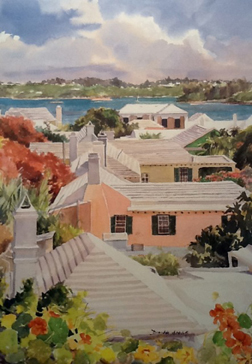 Rooftops painting by Diana Amos of Bermuda shows the water collection roofs seen throughout Bermuda. Painting courtesy of the artist and Windjammer II Gallery in Hamilton, Bermuda at The Fairmont Hamilton Princess |
Bermuda’s architecture features whitewashed stepped roofs designed to channel rainwater into underground tanks. This is the main supply of fresh water as there are no rivers or lakes here. Everything has to come to this Island by boat or plane so a great respect for recycling and gathering water for use in homes has developed. Bermuda is one of the few places in the world that uses a roof catchment and tank system to collect and store rainwater for drinking purposes. This method provides every residence with its own supply of low-cost drinking water and storage tanks are in the lower levels where rainwater flows into from m the collection spouts fed by the roof’s spiral steps.
In1505 Spanish sea captain Juan de Bermúdez spotted the uninhabited islands that will later bear his name, before that time there was no mention of the island. Then, in 1609 the Sea Venture, the flagship of a fleet en route to Jamestown, Virginia with settlers going to the British colony in the New World, was shipwrecked (hundreds of ships have been shipwrecked over the past 400 years) on this coral reef known as Bermuda. Shakespeare’s play The Tempest is thought to be based on the wreck of the Sea Venture. The captain Sir George Somers and 150 passengers and a dog survived. After 10 months all but 3 of the original passengers sailed for Jamestown and it was their arrival with supplies including the wild hogs (that populated the island having survived from previous shipwrecks) that is credited with saving the settlement where only 60 setters remained. In 1612 Settlers returned to Bermuda to form another settlement. There was special exhibition at the Jamestown Settlement and Yorktown Victory Center in Virginia that explored the shared history and links between England’s first two permanent colonies in the New World, on the occasion of Bermuda’s 400th anniversary. Check their site for lectures, images and videos.
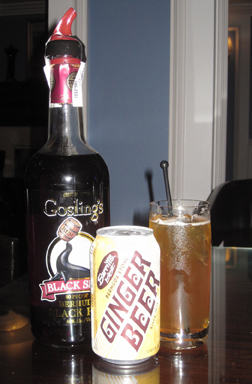 My new favorite drink Dark and Stormy- Ginger Beer and Dark rum |
Upon settling we visited the Windjammer II Gallery in the Hotel and met up with Donjou Anderson, gallery director. The gallery, est. in 1985 is owned by artist Sheilagh Head. She is an excellent impressionist and abstract oil painter and the paintings, sculpture, jewelry, and fine crafts being shown are of very high quality, of different styles and mediums and all made by professional artists of Bermuda. While we were enjoying the colorful and bright work in the large gallery space we met craftsman Milton Hill whose model ships (replicas of historic ships) and other sculptures were on display. Milton uses roots of cedar trees that are 1500 years old. The cedar was used for building homes and ships as it was strong and light. In the 1940’s insects infected 99% of the trees and great effort has been made to plant disease resistant trees. It was a pleasure to meet Milton who was accompanied by one of his several students of ship model making and sculpting with cedar. In 2012, Milton was the recipient of the Bermuda Arts Council’s Founders award.
Dinner at the hotel was with Robin Trimingham, Fairmont Director of Business Travel and Tina Evans Caines, Communications Manager, Bermuda Department of Tourism. Our food was delicious and we were introduced to Dark and Stormy (Dark Gosling rum and Gingerbeer). At dinner we learned that there really is no Bermuda Triangle; Economy is dependent on international business and tourism; Bermuda is not part of the Caribbean; Bermudians are very friendly people; the literacy rate is extremely high; there is no income tax — goods are taxed; salaries are high but the cost of living is very high as most everything has to be imported; many Bermudians have more than 1 job to be able to support themselves and their family; prices of homes are very high; all beaches are public; and that Bermuda Shorts came from the British military’s uniform of the early 20th century for hot climates and that pink is a favorite and Bermudian takes their shorts very seriously, in fact, they passed a law that there can be no shorts shorter than six inches above the knee.
The following morning after a fine breakfast our driver Judith-Ann drove us to Sharon Wilson’s home and studio giving a running commentary about where we were and what we were seeing — which I appreciate. As a gardener I asked Judith-Ann about gardens and crops. There is little room for “crops” but many families have kitchen gardens and raise chickens.
 Artist Sharon Wilson in her studio speaking about herself and her work |
Sharon Wilson is strong spiritually grounded artist and teacher. She is a pastel artist and more recently is using encaustics (wax and pigment) sometime with pastel and charcoal for her figurative work. When she learned that I knew the people at R&F Handmade Paints (manufacturers of Encaustic paints who have their factory in Kingston, NY) she was thrilled and full of questions as she wanted to attend one of their workshops and didn’t know the logistics of getting there, staying there etc. Sharon had been an art teacher for many years at a public school and now she is teaching adults in a small studio in her home. All art supplies have to be ordered (remember this is a very small island with little manufacturing) as does most foods, clothing, supplies — basically everything. Underlying Sharon’s work is empowering women and boys. “I am an artist with a social agenda. I am committed to lifting the human spirit through my art”. In her work as a motivational speaker she says “I speak about the role art can have in holding our dreams foremost in our minds, keeping before us those things we choose to realize in our lives. I am intentionally using art to transform our view; make concrete our thoughts and secure a foundation for meaningful change. This is practical. This takes art out of the elitist realm, out of the world of decoration and places it as an essential ingredient in all our lives”. She does this with her subject matter and by teaching. It was a pleasure to spend time with Sharon and I got a very different view of the black community in Bermuda. About her formative years in the 1950’s she said that “To live in a country where black people represented nearly 60% of the population, but were absent from television, film, magazines, greeting cards etc. was profoundly damaging to my psyche. It damaged my ability to celebrate and value myself, leaving me feeling invisible. This was Bermuda in the 1950’s. Today, invisibility has been replaced by negative stereotyping through the media.” It is her mission to bring positive self-awareness to individuals in the black community. One of the art “projects” she is doing is to make a large medal of a loved one. It resembles a large coin with the image of the loved one and surrounding the image (like “in God we Trust” on our coins) she has a motto that exemplifies that person’s life: eg. We Walk by Faith, Live with Intention. About her own work she says that if play and work are the same there is nothing better for the soul. I hope Sharon makes it to Kingston, I would like very much to see her again.
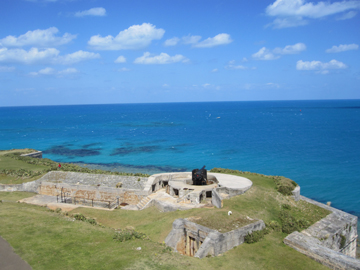 View from the Commissioners House in Dockyard |
We headed to the Royal Naval Dockyard Built in the early 19th century, and Britain’s largest naval base outside the United Kingdom. Housed in the restored historical buildings, are restaurants, shops, museums, working arts and crafts studios, Dockyard Glassworks and the Bermuda Rum Cake Company. The National Museum of Bermuda formerly known as The Bermuda Maritime Museum is a sprawling six-acre fortress at the edge of the Royal Naval Dockyard. Built in 1776 when the British needed fortification against the rebelling colony that was the United States. Eight historic buildings, including old munitions warehouses and the newly restored Commissioner's House, contain a great variety of exhibitions on Bermuda’s history including marine archeology and the many shipwrecks. In the Commissioners House there is an excellent 1,000 sq foot mural created by Graham Foster showing the 400-year history of Bermuda since the 1500’s to today. Within the Museum is Dolphin Quest Bermuda offering year-round interactive encounters with bottlenose dolphins.
The Dockyard is where the hundreds of cruise ships dock and tourists debark to spend time exploring Bermuda and the home of the Spirit of Bermuda, a training vessel for the island’s youth.
Housed in one of the historic buildings is the Bermuda Arts Centre where we met with Heidi Cowen who gave us an overview of the Centre. Within the center are 4 artists’ studios, a small gallery for solo exhibits and a larger gallery for members to show and sell their work. Exhibitions change every 6 weeks. At the time we visited there were 260 artists and 150 non-artists (supporters). The non-profit group, established in 1984 offers a forum for local contemporary artist with the idea of encouraging and supporting their efforts. Funding comes from membership, and individuals and government grants. Heidi’s grandfather was the last of 5 generations of lighthouse keepers and she gives historical tours which seem like an excellent way to learn about the island. Not surprising there is a plein air group that meets each week to paint in different locations including private homes and public spaces. Most of the paintings I saw were watercolors and landscapes/ seascapes.
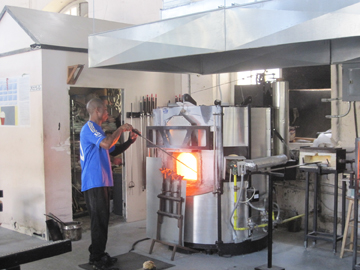 An apprentice working at Dockyard Glassworks Hot Shop & Studio Glass Gallery |
In one of the other buildings is house the Bermuda Rum Cake Company and the Dockyard Glassworks both run by Wendy Avery. There are 11 flavors and they come in 4 sizes. I tasted many of them and they were delicious. Here you will find the only Bermuda Rum cake made in Bermuda (no small pieces of dried fruit, just rum and flavors) Contact them at www.bermudacakes.com and order your cake. Also in this former machine shop is the Dockyard Glassworks Hot Shop and Studio Glass Gallery. Here we saw student glassmakers working along with master glassblowers. The school, begun in 1999 by Tony Johns and Wendy Avery whose optimism is contagious, takes on 7 students each year for a 5-year apprenticeship in glassblowing and flameworking. The company produces high quality hand blown glassware for the tourist industry in Bermuda. Wendy is very involved in supporting craftspeople and the tourism industry. While I was there, Teresa Warner came into the Glassworks to exchange some of her Gombey dolls (a craft she learned from her grandmother Janice Warner Tucker. The Gombey is an iconic symbol of Bermuda, this folklife tradition reflects the island’s blend of African, Native American, Caribbean and British cultures, incorporating them into a unique performance art full of colorful and intricate masquerade, dance and drumming. It goes back to slavery days and was used to depict the feelings against slave masters. Costumes protected them from being recognized by their masters. The suit is colorful and filled with symbols -everything representing something. There are Gombey troups and the training is arduous and children as young as 3 can begin to train. There are dancers and drummers. This past September the Ministry of Culture held a Gombey festival where numerous troups including the Warner Gombeys took part to the delight of hundreds of people.
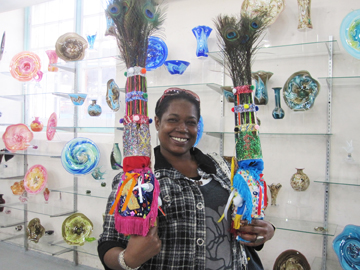 Teresa Warner in the Dockyard Glassworks Hot Shop and Studio Glass Gallery exchanging some of her Gombey dolls |
Another scrumptious dinner at the Blu Resaturant with Joy Sticca, the On-Island Communications Coordinator. We couldn’t resist the Spiney lobster- it was the last week of the season. Spiny lobsters don’t have claws, but instead have long, strong antennae. These lobsters are generally found in warm water and the shells were very hard. Being a fan of lobster and one who eats nearly every part (but the shell) I delighted my tablemates by consuming all the little bits while they just ate the tail. What a waste of a lot of good lobster meat!
The next morning we headed over to St. George for a walking tour. Originally called New London, the Town of St. George was first settled in 1612 and was the capital until 1815 and is the oldest continuously occupied town of English origin in the new world. A wealth of historic architecture gives one the sense of walking back 400 years. There are 17th century homes, colonial landmarks, and thriving businesses, restaurants and shops. St. Peter's, Their Majesties Chappell (title conferred by The Queen in honor of Bermuda’s 400th Anniversary and the Queens Diamond Jubilee) was completed by Christmas 1612 and is the oldest Anglican Church in continuous use outside the British Isles.
The town and its surrounding fortifications were designated in 2000 a World Heritage site by UNESCO. This is the earliest English Urban settlement in the New World and the fortifications illustrate the development of English military engineering. Visitors come from all over the world. We were only in St George’s for a few hours but I can see clearly that a several days wouldn’t give me enough to explore.
 St. Peter’s, Their Majesties Chappell (title conferred by The Queen in honor of Bermuda’s 400th Anniversary and the Queens Diamond Jubilee) completed Christmas 1612 and is the oldest Anglican Church in continuous use outside the British Isles. |
We had a quick boxed lunch and continued on to the Bermuda National Gallery in Hamilton, the capital of Bermuda, where we met Director Lisa Howie and Chairman Gary Phillips. The Gallery, established in 1992, is in the City Hall & Arts Center and opened with the donated collection of Hereward T. Watlington a founding trustee of the and artist. The vast programs and exhibitions present works by local and international artists reflecting the islands rich multicultural heritage. There are several collections in the Gallery. The African Collection has work from 12 countries in Sub Saharan, West Africa and includes ritual sculptures, masks, functional objects and textiles that came out of Africa in the 1940’s & 50’s. The collection is a celebration of African cultures and creativity. The Bermuda Collection is a history of the fine and decorative arts in Bermuda over the last 350 years. Decorative Arts, influence of the military, first Bermudian artists, the influence of tourism on Art in Bermuda and the influence of globalization on Contemporary Art in Bermuda are all part of this collection. While I was there I saw an exhibition of works by internationally known artists who had spent time and worked in Bermuda. The European Collection is the Watlington collection and includes works by well-known artists from the 15th to 18th centuries.
The Mandate of the Bermuda National Gallery’s educational program is to bring the experience of art to every child in Bermuda. This is being done by several ways: to encourage teachers and curriculum builders to use the Bermuda collection as a part of the class learning experience; an extensive education center; an outreach program to the schools; art camp; professional development for teachers. It is the hope that a mandatory visit to the museum will be written into the curriculum. The Virtual Tour of the gallery makes visiting the gallery less daunting as students and teachers can preview exhibits in preparation for a visit to the or for individuals who may not have the means of coming to the actual location. The Gallery has student and adult docents and they have prepared lesson guides for the permanent and new exhibits. Many of their catalogues are freely available on the Gallery site: bermudanationalgallery.com. While I was there I saw a very moving exhibition that focused on justice and injustices and we learned that there is poverty in paradise. Current and upcoming exhibits can also be explored on the Gallery’s website.
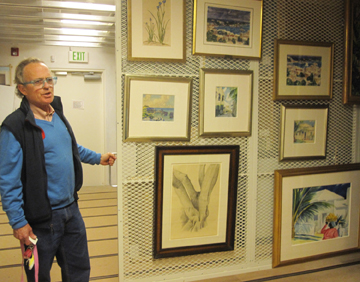 Tom Butterfield, Founder and Creative Director of Masterworks shows us some of the work in the storage area. |
We had a little free time in Hamilton so I took the ferry to Dockyard just to have some time on the water and to see the island from a different vantage point. It was glorious. We had drinks with Stacey Evans, Assistant Director of Promotional Services and then yet another excellent dinner at Port-O-Call restaurant.
The next and our last day we headed over to Masterworks: Museum of Bermuda Art and met with founder and creative directory Tom Butterfield. In 2008, after being a nomadic collection, paintings are now under one climate controlled roof, in a world class museum with art storage facilities, a classroom, a main gallery, a smaller gallery dedicated to local artists and a members lounge, café and gift shop. Tom Butterfield’s pride and enthusiasm was palpable as he showed us the museum and particularly the storage facility with art, many of them works by Georgia O’Keefe, Winslow Homer, Marston Hartley, Charles Damuth and others that were painted in Bermuda. Their mission is to build a major collection, of Bermuda art from the past and the present. The lectures, art camp, classes and workshops all serve to further their outreach to the community and the residence program is open to all artists from around the world. Specific to Bermuda is an annual competition: The Charman Prize, with a $10,000 prize. The prize honors and supports Bermuda visual artists in the creation of their art. It is Tom’s dream to have works repatriated and to that end they are actively searching out works of art inspired by the island. Masterworks is the 3rd most visited place with Dockyard and Horseshoe Bay leading. Outside the Museum are several sculptures, the most famous The Double Fantasy, is dedicated to John Lennon who sailed to the island in 1980 and wrote songs for his final album “Double Fantasy”, named for an island flower. The Masterworks Museum commissioned painter and sculptor Graham Foster who is best known for his huge mural ‘The Hall of History’ inside the Commissioner's House at the Bermuda National Museum in Dockyard.
While I was in Bermuda it felt like time stood still. This beautiful Island with over 300 events each year is an exciting destination for relaxing, exploring and surely immersing oneself into another culture.
